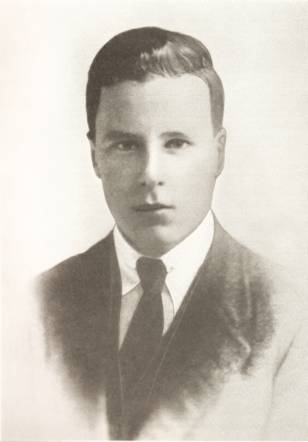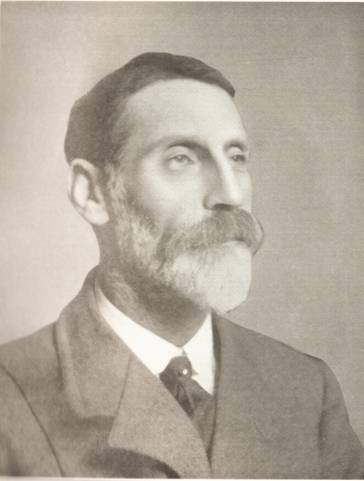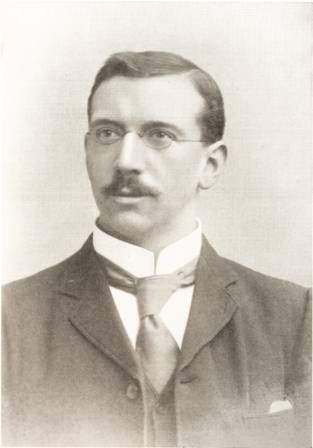In Memoriam
James Anson Farrer
By the death of Mr. James Anson Farrer the Club has lost one, who if not actively associated with us in our outdoor activities was so much in sympathy with us as to fully deserve the distinction of Honorary Membership.
The home at Clapham (“Ingleborough”) to which Mr. Farrer had the good fortune to succeed has charms of no common kind. A house of great dignity, full of the family treasures of several generations, stands in a garden famous through all the country, just where the limestone slopes begin to rear themselves into the mountain mass of Ingleborough.
Ingleborough (or Clapham) Cave, the chief treasure of Mr. Farrer’s domain, was first explored by his predecessors while Gaping Ghyll, which also lies in the estate, was first descended by M. Martel in 1895, Mr. Farrer affording him every possible assistance, as indeed he has done on every occasion when the Ghyll has been descended by our members.
His tastes were literary and he was an author of some standing. While outwardly the most diffident of men, he had in matters of belief and opinion great strength of character and he was never afraid to defend by tongue and pen an unpopular cause.
J.J.B.
Arthur Sheridan Lowden
I approach the task of writing something in memory of “Ted” Lowden with considerable diffidence. A sportsman who undertook his expeditions for the sheer joy of achievement, he gave the impression he did not like his doings recorded in print. Then, too, although more than a year has gone since his death I still feel his absence very keenly, as all his more intimate friends in the Club still do.
No doubt our first meeting was at Almescliff, where he was a regular visitor, and was soon a very skilful climber. He made a complete descent of Alum Pot in 1922 with us under none too good conditions, and joined the Club in 1923 when he was taking an engineering course at Leeds University. My first real holiday with him was two or three weeks climbing at Turtegrö in that year, his first experience of the greater peaks. He was a most delightful and interesting companion ; apart from the fact that he confessed to nerves once or twice one would never have thought that any situation disturbed him, and one instinctively felt that he could be relied on to do the right thing in an emergency. A fearless climber and skilful, he was able to gauge his own capabilities accurately.
We made the first ascent for the season of Skagastölstind by Heftye’s Rende, and later he and Anderson covered a big distance on tramp, frequently making a fire at night and sleeping in the open-just the life he loved.
In 1924 he made many pot-holing expeditions in the Ingleborough district, and at the Whitsuntide descent of Gaping Ghyll he was with the first party, and had an exceedingly rough ascent owing to the heavy flood.
His work on the engine will be remembered by all his comrades, and this performance and his general keenness led to his choice as Junior Secretary for 1924-5.
The climb of the Amphitheatre Buttress from Ogwen next Easter, and others we had together are full of happy memories, of a night motor run to Wasdale and three splendid days on Pillar, Gable, and Scawfell, of nights under canvas by Wastwater. Some men will remember him best as a youthful and hardened veteran of pot-holing. With Lowden the pleasure of the expedition was always there.
We saw him last in the flush of his strength at a Committee meeting in October, 1925, oddly enough attended by every available member, and the same night he met with a fatal motor cycle accident.
Lowden lingered almost till Christmas and through his death the Club lost one of its youngest and most enthusiastic members who had done much for it, and who had made many staunch friends. We miss him at our meets, but we are the richer by memories of joyous struggle which would not have been ours had he not been a Yorkshire Rambler.
C.E.B.
Joseph William Swithinbank.
1863-1926.
By the death of J.W. Swithinbank in March, 1926, the Club loses one of its oldest members and one of the stalwarts in everything that affected its interests. Swithinbank was born in Leeds in 1863, and after a public school education joined the Leeds branch of the National Telephone Company in 1881. During 42 years of excellent service with the old company and with the Post Office he worked for varying periods as responsible official for Huddersfield, Leeds, Durham, Hull and Sheffield, and on his retirement from the Postal Telephone Service in 1923 remarkable tributes of appreciation of his work were paid by the Sheffield Press in general.
But it was as a member of the Yorkshire Ramblers’ Club that we, who for nearly 30 years were associated with him in its objects, would wish to remember him. Thirty years ago no pot-holing expedition was complete without him, evidenced by the fact that he was associated with the first descent of Rowten Pot, Jingling Pot and Bull Pot on Gragreth, Lost John’s, Marble Steps, Rift Pot, Death’s Head, and Rumbling Hole. In addition to these there was scarcely an expedition of any importance in which he was not a member of the party, and even up to a very short time before his death, when he had had more than one serious operation, he was keen and enthusiastic enough to make his second descent of Death’s Head Pot.
Swithinbank was one of those enthusiastically good-natured individuals from whose presence appear to ooze cheeriness, good humour and optimism. In fact, the more depressing the conditions and the more uncomfortable the surroundings, the more his spirits rose and his cheeriness prevailed. A brave but a safe man, he was an ideal member of an expedition. In addition to his personal qualities and climbing skill, his knowledge of telephony and his general handiness made him one of the most useful men on a pot-holing expedition. He it was who converted telephony as we practise it from an ideal into a reality. But after all it was the spirit of the man which was his greatest asset. To be in any party with Swithinbank was a delight; to have lost him is a sincere grief.
W.P.
John Arthur Green.
The sad news of the death of Jack Green, one of the founders and first secretary of the Yorkshire Ramblers’ Club, came as a shock to the members and especially to those who were his intimate associates in the days of our formation. He died 17th August, 1926, at the comparatively early age of 56 years. For some time he had shown signs of failing health which in one so strong and hardy puzzled his friends. Towards the end the symptoms were very noticeable and aroused grave misgivings in their minds.
I first met him in the late eighties when he joined the Leeds Harriers. He was a sturdy and tireless runner and from the first we were mutually attached to each other, and in company with Herbert Slater he and I enjoyed many rambles together. A tour on the Roman Wall from Brough on Solway to Newcastle-on-Tyne cemented a long friendship among the three of us. Another outing at Easter, 1888, with Wm. Arthur Howgate at Robin Hood’s Bay proved equally interesting. He was then in the service of the N.E.R. Co., which he left to enter Beckett’s Bank on my father’s recommendation. In 1899 he was appointed head cashier of the Yorkshire Penny Bank, Leeds, and in 1908 he became manager of the Leeds Branch. In 1913 he left the bank to go to the Wood Powell Process Syndicate Ltd., London. He rejoined the Yorkshire Penny Bank staff at the end of 1920, and immediately became manager of the new Mansfield Branch. From Mansfield he was appointed manager of the Harrogate Branch in 1924. Here his failing health began to be very marked and the end came rather suddenly. He lies in the Harlow Hill Cemetery, Harrogate, where he was buried on the 19th August, 1926. Our club was represented by Messrs. T. S. Booth, Lewis Moore, F. Leach and J.H.Buckley.
A very tangible proof of his deep affection for the Ramblers is a legacy of twenty pounds to the Club.
Green was many years officially connected with the Y.R.C. as the following list will show:- Secretary ,1892-1893 ; Committee, 1893-1895, and 1896-98 ; Vice-President, 1904-1906 ; Committee, 1906-1909 ; Joint Secretary, 1910-1912; Committee, 1912-1913. He also did good work for the Journal, to which he contributed several articles. In 1922 he was proposed as President; but the matter was not proceeded with on account of his being resident in the Midlands which would have prevented him from an active participation in the affairs of the Club.
He did some climbing in Switzerland and in Norway, 1900 and 1904, among the Horungtinder. He was one of the frequenters of Almescliff and as his interest grew he became a very good rock climber. He was with Alfred Holmes and the Rev. A. D. Tupper-Carey at Wasdale Head, Easter 1895, when I was there with Booth, Leach, Moore and others, where we met J. W. Robinson, Owen Glynne Jones and many other men of climbing fame. Green was one of the six Ramblers who made the second descent of Gaping Ghyll, the year after M. Martel’s descent in 1895. He was also in the party to make the first descent of Pillar Pot and Rift Pot.
As Green lay on his death-bed his thoughts were often with the past and with the Yorkshire Ramblers. He left them a message, that the best thing he ever did or wrote was “The Joys of the Open Fell.” They will find the article in the second volume of the Journal. We older men will miss him keenly and regret his loss; but we recall our past with pleasure, and look forward to the reunion of kindred spirits when our own time shall end and we cross the bar into the unknown.
G.T.L.


